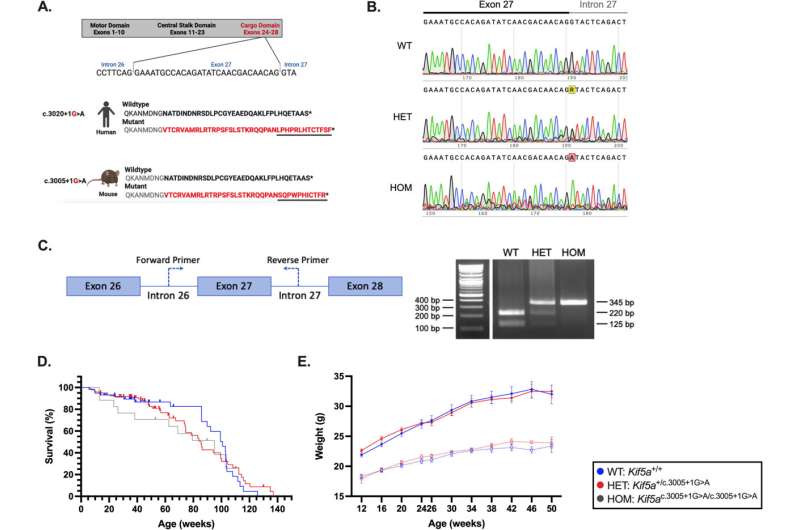This article has been reviewed according to Science X's editorial process and policies. Editors have highlighted the following attributes while ensuring the content's credibility:
fact-checked
peer-reviewed publication
trusted source
proofread
Study examines the possible role of KIF5A gene in ALS

A study by researchers at The Ohio State University Wexner Medical Center and College of Medicine used a newly developed mouse model to examine the possible role of a gene called KIF5A in the development of amyotrophic lateral sclerosis (ALS).
Normally, KIF5A codes for a protein that transports essential molecules forward along an axon, or nerve fiber. Genome-wide association studies have linked a variant (i.e., mutation) of KIF5A to ALS. This study examined how this variant might contribute to the development of the disease.
"Our findings could lead to a better understanding of how ALS develops in people who have this mutation," said principal investigator Stephen Kolb, MD, Ph.D., professor of neurology and biological chemistry and pharmacology at Ohio State.
Kolb and his colleagues developed the animal model that incorporates an altered version of the mouse Kif5a gene called "Kif5a variant (c.3005+1G>A)." At one year of age, both animals that had one copy (heterozygous) and two copies (homozygous) of the gene showed normal survival, weight and motor function.
When subjected to nerve injury, however, both heterozygous and homozygous animals showed delayed repair of motor units (neurons and the group of muscle fibers they innervate) compared to mice with normal Kif5a genes.
After two years, aged mutated mice showed even poorer repair of motor units following injury, suggesting that Kif5a variants and age work together to reduce the ability of axons to repair motor units after injury.
The researchers reported their findings in the journal Neurobiology of Disease.
"Humans who have ALS-associated KIF5A variants appear healthy for decades before the onset of symptoms," Kolb said. "Our findings suggest that the onset of disease in these individuals might result from the accumulation of stressors such as nerve damage and changes due to aging, resulting in a failure by axons to repair the damage and maintain motor units."
Kolb added, "Our knock-in splice mutation is more representative of ALS mutations found in clinical settings, but it does not exhibit the motor-neuron degeneration that is characteristic of ALS. This is a perennial challenge in ALS research."
ALS is a neurodegenerative disease that causes progressive loss of muscle control and eventual paralysis. Individuals lose muscle strength and the ability to move, speak, eat and breathe.
According to the Centers for Disease Control and Prevention, about 5,000 new cases of ALS are diagnosed each year in the United States, with most people living two to five years after symptoms develop. The cause of ALS is unknown.
More information: Kelly A. Rich et al, Impaired motor unit recovery and maintenance in a knock-in mouse model of ALS-associated Kif5a variant, Neurobiology of Disease (2023). DOI: 10.1016/j.nbd.2023.106148
















